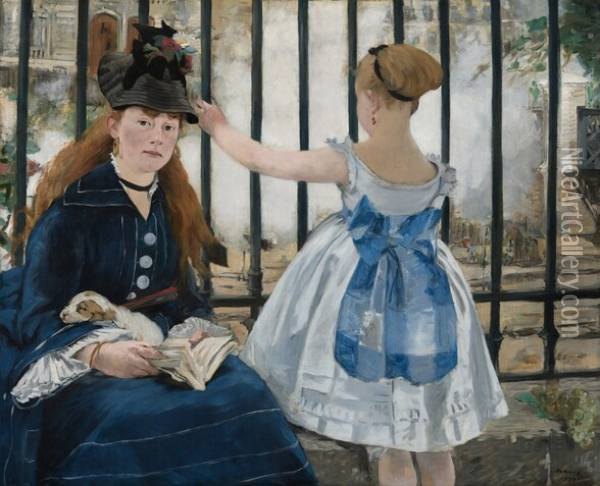Édouard Manet’s “The Railway” (1873) stands as a captivating exploration of modern life and urban transformation in 19th-century Paris. This painting, notable for its innovative composition and use of color, captures a moment of everyday life against the backdrop of the industrial age. In this article, we explore the nuances of “The Railway,” delving into how Manet portrays the complexities of modernity through his unique artistic lens.
This piece is not just a representation of an urban landscape but also a commentary on the changing social and physical landscape of Paris during a time of rapid industrialization. Through a detailed examination, we aim to understand the layers of meaning behind this intriguing depiction of modern life.
Historical Context
“The Railway” was painted during a period of significant change in Paris. The city was undergoing modernization, with the expansion of the railway system symbolizing progress and the industrial revolution. This era saw the transformation of Paris into a modern metropolis, marked by technological advancements and shifting social dynamics.
Manet, known for his keen observation of contemporary life, captured these changes in his artwork. “The Railway” reflects the zeitgeist of the era, portraying the coexistence of the old and the new and the impact of industrialization on daily life. The painting offers a snapshot of this transformative period, providing insight into the urban experience of the time.
Description of the Painting
In “The Railway,” Manet depicts a young woman and a child sitting beside a railway track. The woman, gazing pensively into the distance, is juxtaposed against a backdrop of steam and rail, symbolizing the industrial age. The child, turned towards the viewer, adds a sense of immediacy and intimacy to the scene.
The use of color and light in this painting is striking. Manet employs a palette that captures the vibrancy of the cityscape and the transient nature of light. The brushwork is loose and expressive, contributing to the dynamic and modern feel of the work. This approach highlights the juxtaposition of the human element within the urban industrial environment.
Artistic Techniques and Innovations
Manet’s technique in “The Railway” was innovative for its time. His approach to composition, eschewing traditional perspectives in favor of a more immediate and fragmented view, was groundbreaking. This technique reflects the fragmentation and discontinuity experienced in modern urban life.
Furthermore, Manet’s use of color and texture brings a sense of vitality and movement to the painting. The steam from the train, rendered in subtle shades of gray and white, contrasts with the vivid colors of the figures’ clothing, emphasizing the interplay between humanity and industry. This use of color and form captures the essence of the modern city, marked by constant movement and change.
Deeper Analysis of Urban and Social Themes
“The Railway” goes beyond a mere depiction of a railway scene; it delves into the broader themes of urbanization and social change. The painting reflects the tension between the new, industrialized world and the traditional way of life. The woman and child, positioned in the foreground, represent the human aspect of this evolving urban landscape, offering a contemplative contrast to the impersonal backdrop of the railway and steam.
Manet’s depiction of the woman, possibly a nanny or a mother, along with the child, underscores the changing roles and dynamics within society. Their placement by the railway, a symbol of progress and modernity, speaks to the inescapable presence of industrialization in everyday life. This juxtaposition highlights the complexities of adapting to a rapidly changing world, a theme that resonates with the experiences of many during this era.
Symbolism and Cultural Significance
The painting is rich in symbolism, with the railway serving as a powerful metaphor for progress and the relentless march of modernity. The steam, obscuring parts of the background, symbolizes the uncertainty and ambiguity that accompanied these changes. Meanwhile, the fence separating the figures from the railway track could represent the barriers and divisions created by urbanization, both physically and socially.
Culturally, “The Railway” captures a moment in time when Paris was at the cusp of becoming a modern city. The painting reflects the fascination and apprehension with which these changes were viewed. It also signifies the role of art in documenting and responding to societal transformations, offering insights into how people perceived and adapted to the new realities of urban living.
Influence and Legacy
Manet’s “The Railway” had a significant impact on the development of modern art. Its innovative composition and thematic focus influenced contemporaries and later artists, contributing to the evolution of artistic approaches to urban subjects. The painting is often cited as an important precursor to Impressionism, with its emphasis on modern life, use of light, and candid portrayal of everyday scenes.
The legacy of “The Railway” extends to its role in capturing a pivotal moment in urban history. It remains an important work for understanding the impact of industrialization on society and the arts. The painting continues to be celebrated for its artistic merits and as a window into the social and cultural shifts of late 19th-century Paris.
Conclusion
Édouard Manet‘s “The Railway” is a masterpiece that encapsulates the essence of modern urban life in the 19th century. Through this work, Manet not only captured the physical changes brought about by industrialization but also explored the nuanced human responses to these changes. The painting stands as a testament to Manet’s visionary approach, illustrating the intersection of art, society, and the rapidly evolving urban landscape. It remains a vital piece for understanding the complexities of modernization and the enduring impact of industrial progress on human life and artistic expression.

